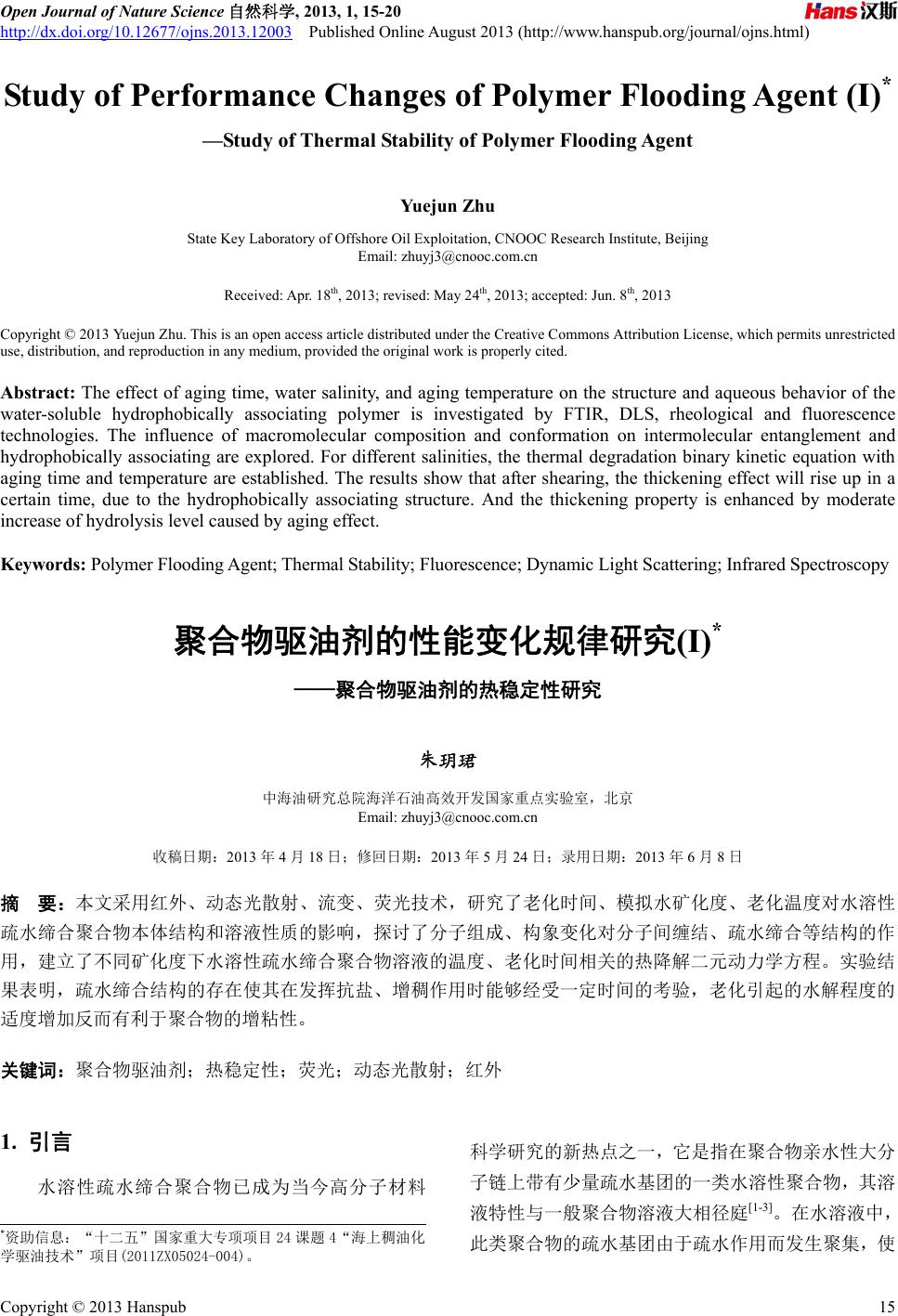 Open Journal of Nature Science自然科学, 2013, 1, 15-20 http://dx.doi.org/10.12677/ojns.2013.12003 Published Online August 2013 (http://www.hanspub.org/journal/ojns.html) Study of Performance Changes of Polymer Flooding Agent (I)* —Study of Thermal Stability of Polymer Flooding Agent Yuejun Zhu State Key Laboratory of Offshore Oil Exploitation, CNOOC Research Institute, Beijing Email: zhuyj3@cnooc.com.cn Received: Apr. 18th, 2013; revised: May 24th, 2013; accepted: Jun. 8th, 2013 Copyright © 2013 Yuejun Zhu. This is an open access article distributed under the Creative Commons Attribution License, which permits unrestricted use, distribution, and reproduction in any medium, provided the original work is properly cited. Abstract: The effect of aging time, water salinity, and aging temperature on the structure and aqueous behavior of the water-soluble hydrophobically associating polymer is investigated by FTIR, DLS, rheological and fluorescence technologies. The influence of macromolecular composition and conformation on intermolecular entanglement and hydrophobically associating are explored. For different salinities, the thermal degradation binary kinetic equation with aging time and temperature are established. The results show that after shearing, the thickening effect will rise up in a certain time, due to the hydrophobically associating structure. And the thickening property is enhanced by moderate increase of hydrolysis level caused by aging effect. Keywords: Polymer Flooding Agent; Thermal Stability; Fluorescence; Dynamic Light Scattering; Infrared Spectroscopy 聚合物驱油剂的性能变化规律研究(I)* ——聚合物驱油剂的热稳定性研究 朱玥珺 中海油研究总院海洋石油高效开发国家重点实验室,北京 Email: zhuyj3@cnooc.com.cn 收稿日期:2013 年4月18 日;修回日期:2013年5月24日;录用日期:2013 年6月8日 摘 要:本文采用红外、动态光散射、流变、荧光技术,研究了老化时间、模拟水矿化度、老化温度对水溶性 疏水缔合聚合物本体结构和溶液性质的影响,探讨了分子组成、构象变化对分子间缠结、疏水缔合等结构的作 用,建立了不同矿化度下水溶性疏水缔合聚合物溶液的温度、老化时间相关的热降解二元动力学方程。实验结 果表明,疏水缔合结构的存在使其在发挥抗盐、增稠作用时能够经受一定时间的考验,老化引起的水解程度的 适度增加反而有利于聚合物的增粘性。 关键词:聚合物驱油剂;热稳定性;荧光;动态光散射;红外 1. 引言 水溶性疏水缔合聚合物已成为当今高分子材料 科学研究的新热点之一,它是指在聚合物亲水性大分 子链上带有少量疏水基团的一类水溶性聚合物,其溶 液特性与一般聚合物溶液大相径庭[1-3]。在水溶液中, 此类聚合物的疏水基团由于疏水作用而发生聚集,使 *资助信息:“十二五”国家重大专项项目 24 课题4“海上稠油化 学驱油技术”项目(2011ZX05024-004)。 Copyright © 2013 Hanspub 15 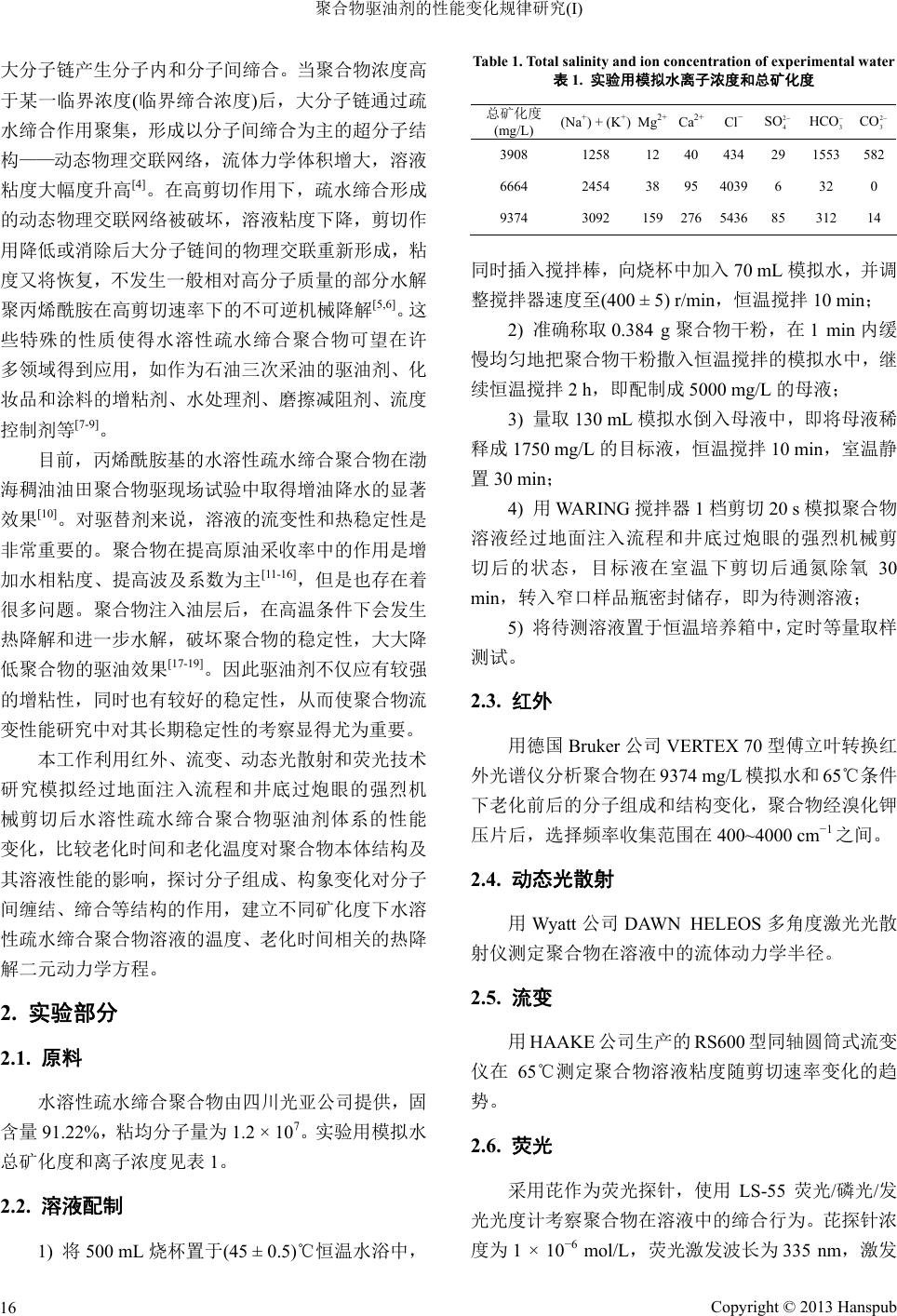 聚合物驱油剂的性能变化规律研究(I) 大分子链产生分子内和分子间缔合。当聚合物浓度高 于某一临界浓度(临界缔合浓度)后,大分子链通过疏 水缔合作用聚集,形成以分子间缔合为主的超分子结 构——动态物理交联网络,流体力学体积增大,溶液 粘度大幅度升高[4]。在高剪切作用下,疏水缔合形成 的动态物理交联网络被破坏,溶液粘度下降,剪切作 用降低或消除后大分子链间的物理交联重新形成,粘 度又将恢复,不发生一般相对高分子质量的部分水解 聚丙烯酰胺在高剪切速率下的不可逆机械降解[5,6]。这 些特殊的性质使得水溶性疏水缔合聚合物可望在许 多领域得到应用,如作为石油三次采油的驱油剂、化 妆品和涂料的增粘剂、水处理剂、磨擦减阻剂、流度 控制剂等[7-9]。 目前,丙烯酰胺基的水溶性疏水缔合聚合物在渤 海稠油油田聚合物驱现场试验中取得增油降水的显著 效果[10]。对驱替剂来说,溶液的流变性和热稳定性是 非常重要的。聚合物在提高原油采收率中的作用是增 加水相粘度、提高波及系数为主[11-16],但是也存在着 很多问题。聚合物注入油层后,在高温条件下会发生 热降解和进一步水解,破坏聚合物的稳定性,大大降 低聚合物的驱油效果[17-19]。因此驱油剂不仅应有较强 的增粘性,同时也有较好的稳定性,从而使聚合物流 变性能研究中对其长期稳定性的考察显得尤为重要。 本工作利用红外、流变、动态光散射和荧光技术 研究模拟经过地面注入流程和井底过炮眼的强烈机 械剪切后水溶性疏水缔合聚合物驱油剂体系的性能 变化,比较老化时间和老化温度对聚合物本体结构及 其溶液性能的影响,探讨分子组成、构象变化对分子 间缠结、缔合等结构的作用,建立不同矿化度下水溶 性疏水缔合聚合物溶液的温度、老化时间相关的热降 解二元动力学方程。 2. 实验部分 2.1. 原料 水溶性疏水缔合聚合物由四川光亚公司提供,固 含量 91.22%,粘均分子量为1.2 × 107。实验用模拟水 总矿化度和离子浓度见表 1。 2.2. 溶液配制 1) 将500 mL 烧杯置于(45 ± 0.5)℃恒温水浴中, Table 1. Total salinity and ion concentration of experimental water 表1. 实验用模拟水离子浓度和总矿化度 总矿化度 (mg/L) (Na+) + (K+)Mg 2+ Ca2+ Cl− 2 4 SO 3 HCO 2 3 CO 3908 1258 1240 434 29 1553582 6664 2454 3895 4039 6 32 0 9374 3092 159276 5436 85 312 14 同时插入搅拌棒,向烧杯中加入 70 mL 模拟水,并调 整搅拌器速度至(400 ± 5) r/min,恒温搅拌10 min; 2) 准确称取 0.384 g聚合物干粉,在1 min内缓 慢均匀地把聚合物干粉撒入恒温搅拌的模拟水中,继 续恒温搅拌 2 h,即配制成 5000 mg/L 的母液; 3) 量取130 mL 模拟水倒入母液中,即将母液稀 释成 1750 mg/L 的目标液,恒温搅拌10 min,室温静 置30 min; 4) 用WA R I N G搅拌器 1档剪切20 s 模拟聚合物 溶液经过地面注入流程和井底过炮眼的强烈机械剪 切后的状态,目标液在室温下剪切后通氮除氧 30 min,转入窄口样品瓶密封储存,即为待测溶液; 5) 将待测溶液置于恒温培养箱中,定时等量取样 测试。 2.3. 红外 用德国 Bruker 公司 VERTEX 70 型傅立叶转换红 外光谱仪分析聚合物在 9374 mg/L模拟水和 65℃条件 下老化前后的分子组成和结构变化,聚合物经溴化钾 压片后,选择频率收集范围在400~4000 cm−1之间。 2.4. 动态光散射 用Wyatt 公司 DAWN HELEOS多角度激光光散 射仪测定聚合物在溶液中的流体动力学半径。 2.5. 流变 用HAAKE公司生产的 RS600型同轴圆筒式流变 仪在 65℃测定聚合物溶液粘度随剪切速率变化的趋 势。 2.6. 荧光 采用芘作为荧光探针,使用LS-55 荧光/磷光/发 光光度计考察聚合物在溶液中的缔合行为。芘探针浓 度为 1 × 10−6 mol/L,荧光激发波长为 335 nm,激发 Copyright © 2013 Hanspub 16 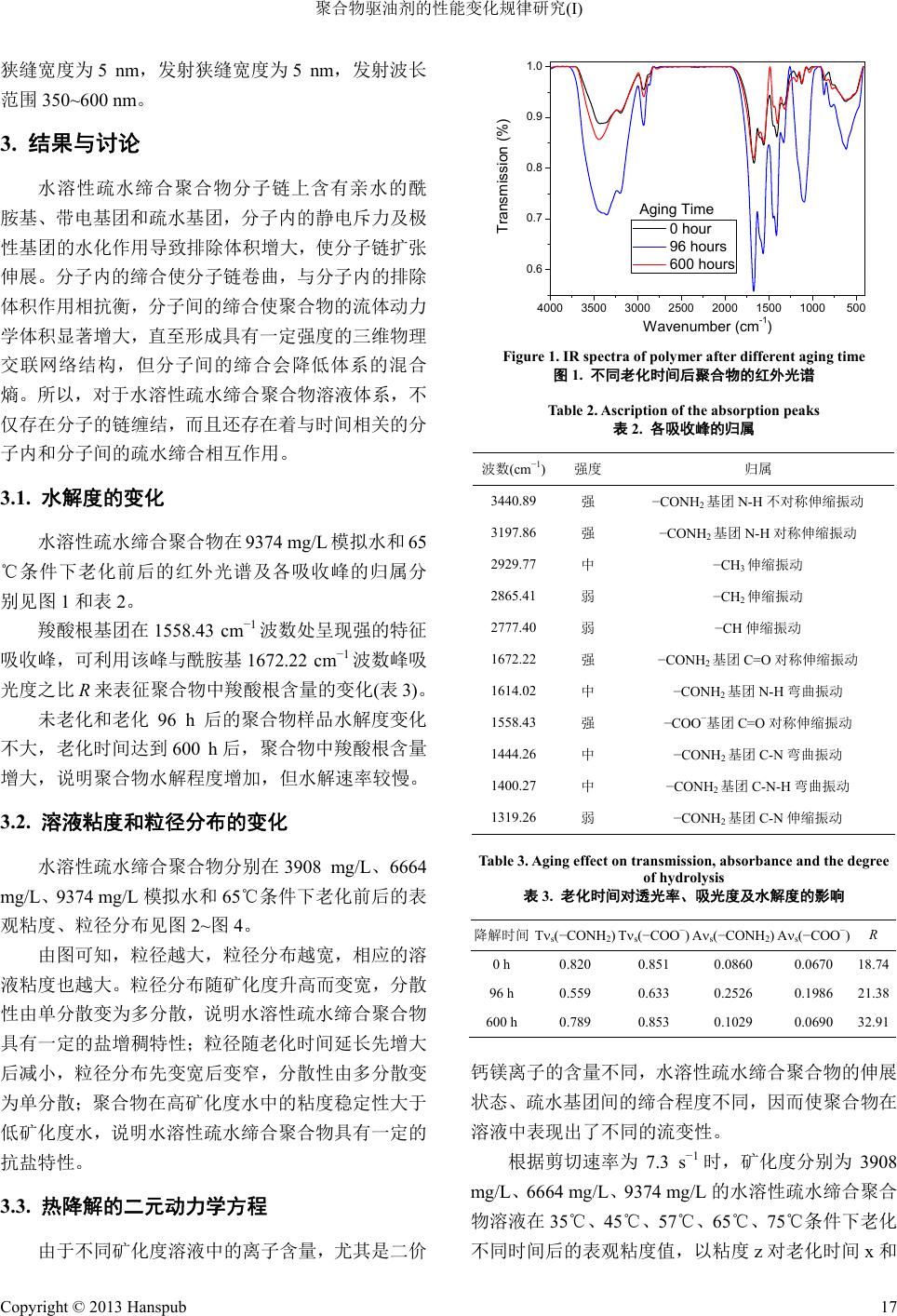 聚合物驱油剂的性能变化规律研究(I) 狭缝宽度为 5 nm,发射狭缝宽度为5 nm,发射波长 范围 350~600 nm。 3. 结果与讨论 水溶性疏水缔合聚合物分子链上含有亲水的酰 胺基、带电基团和疏水基团,分子内的静电斥力及极 性基团的水化作用导致排除体积增大,使分子链扩张 伸展。分子内的缔合使分子链卷曲,与分子内的排除 体积作用相抗衡,分子间的缔合使聚合物的流体动力 学体积显著增大,直至形成具有一定强度的三维物理 交联网络结构,但分子间的缔合会降低体系的混合 熵。所以,对于水溶性疏水缔合聚合物溶液体系,不 仅存在分子的链缠结,而且还存在着与时间相关的分 子内和分子间的疏水缔合相互作用。 3.1. 水解度的变化 水溶性疏水缔合聚合物在 9374 mg/L模拟水和 65 ℃条件下老化前后的红外光谱及各吸收峰的归属分 别见图 1和表 2。 羧酸根基团在1558.43 cm−1波数处呈现强的特征 吸收峰,可利用该峰与酰胺基1672.22 cm−1波数峰吸 光度之比 R来表征聚合物中羧酸根含量的变化(表3)。 未老化和老化96 h 后的聚合物样品水解度变化 不大,老化时间达到 600 h后,聚合物中羧酸根含量 增大,说明聚合物水解程度增加,但水解速率较慢。 3.2. 溶液粘度和粒径分布的变化 水溶性疏水缔合聚合物分别在3908 mg/L、6664 mg/L 、9374 mg/L 模拟水和 65℃条件下老化前后的表 观粘度、粒径分布见图2~图4。 由图可知,粒径越大,粒径分布越宽,相应的溶 液粘度也越大。粒径分布随矿化度升高而变宽,分散 性由单分散变为多分散,说明水溶性疏水缔合聚合物 具有一定的盐增稠特性;粒径随老化时间延长先增大 后减小,粒径分布先变宽后变窄,分散性由多分散变 为单分散;聚合物在高矿化度水中的粘度稳定性大于 低矿化度水,说明水溶性疏水缔合聚合物具有一定的 抗盐特性。 3.3. 热降解的二元动力学方程 由于不同矿化度溶液中的离子含量,尤其是二价 4000 3500 3000 2500 2000 1500 1000500 0.6 0.7 0.8 0.9 1.0 Transmission (%) Wavenumber ( cm-1 ) 0 hour 96 hours 600 hours Aging Time Figure 1. IR spectra of polymer after different aging time 图1. 不同老化时间后聚合物的红外光谱 Table 2. Ascription of the absorption peaks 表2. 各吸收峰的归属 波数(cm−1)强度 归属 3440.89 强 −CONH2基团 N-H不对称伸缩振动 3197.86 强 −CONH2基团 N-H对称伸缩振动 2929.77 中 −CH3伸缩振动 2865.41 弱 −CH2伸缩振动 2777.40 弱 −CH 伸缩振动 1672.22 强 −CONH2基团 C=O 对称伸缩振动 1614.02 中 −CONH2基团 N-H弯曲振动 1558.43 强 −COO−基团 C=O 对称伸缩振动 1444.26 中 −CONH2基团 C-N弯曲振动 1400.27 中 −CONH2基团 C-N-H 弯曲振动 1319.26 弱 −CONH2基团 C-N伸缩振动 Table 3. Aging effect on transmission, absorbance and the degree of hydrolysis 表3. 老化时间对透光率、吸光度及水解度的影响 降解时间 Ts(−CONH2)Ts(−COO−) As(−CONH2) As(−COO−)R 0 h 0.820 0.851 0.0860 0.0670 18.74 96 h 0.559 0.633 0.2526 0.1986 21.38 600 h 0.789 0.853 0.1029 0.0690 32.91 钙镁离子的含量不同,水溶性疏水缔合聚合物的伸展 状态、疏水基团间的缔合程度不同,因而使聚合物在 溶液中表现出了不同的流变性。 根据剪切速率为 7.3 s−1时,矿化度分别为 3908 mg/L 、6664 mg/L、9374 mg/L 的水溶性疏水缔合聚合 物溶液在35℃、45℃、57℃、65℃、75℃条件下老化 不同时间后的表观粘度值,以粘度 z对老化时间 x和 Copyright © 2013 Hanspub 17 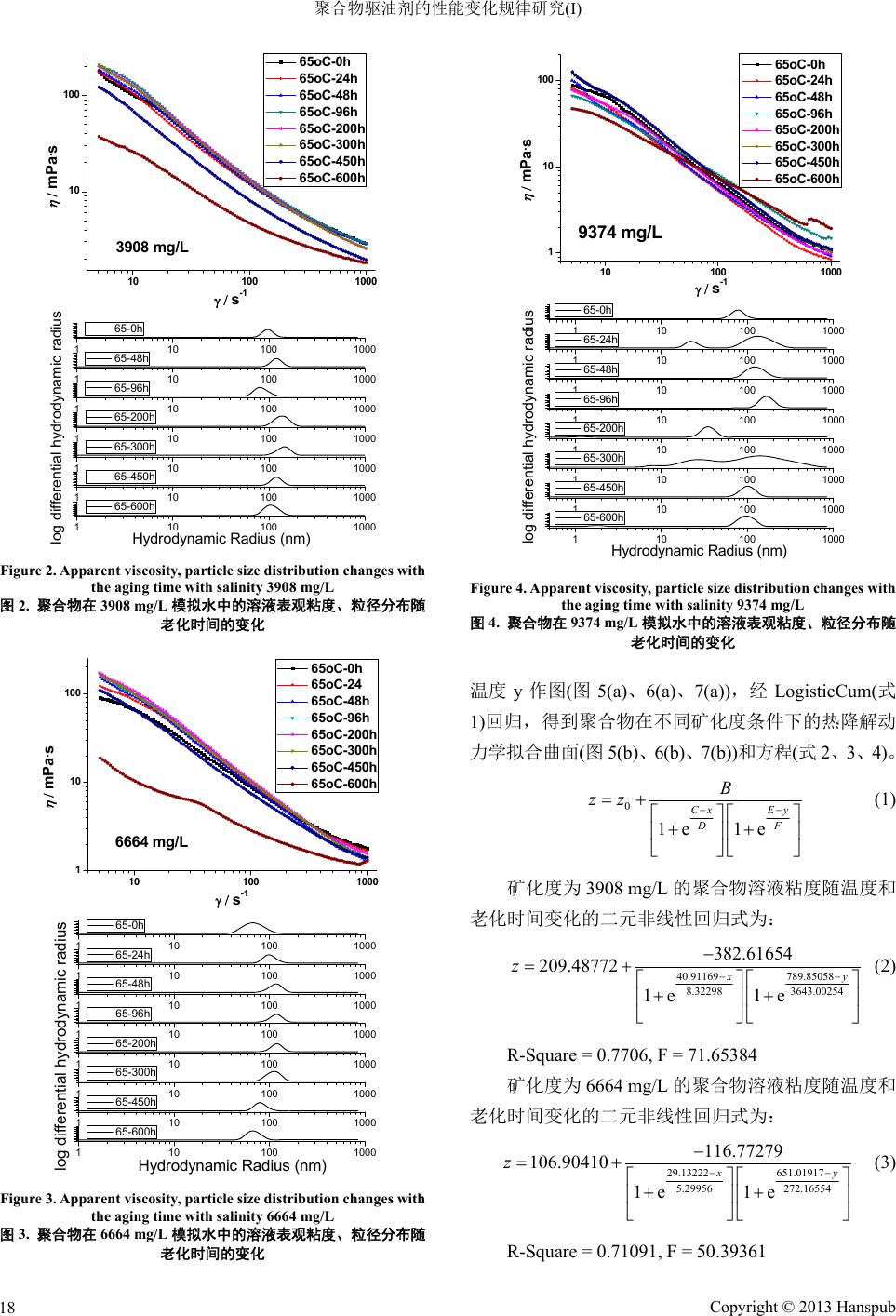 聚合物驱油剂的性能变化规律研究(I) 10100 1000 10 100 3908 mg/L m P a.s s-1 65oC-0h 65oC-24h 65oC-48h 65oC-96h 65oC-200h 65oC-300h 65oC-450h 65oC-600h 110100 1000 110100 1000 110100 1000 110100 1000 110100 1000 110100 1000 110100 1000 log differential hydrodynamic radius H y drod y namic Radius ( nm ) 65-0h 65-48h 65-96h 65-200h 65-300h 65-450h 65-600h Figure 2. Apparent viscosity, particle size distribution changes with the aging time with salinity 3908 mg/L 图2. 聚合物在 3908 mg/L模拟水中的溶液表观粘度、粒径分布随 老化时间的变化 10100 1000 1 10 100 6664 mg/L m P a.s s-1 65oC-0h 65oC-24 65oC-48h 65oC-96h 65oC-200h 65oC-300h 65oC-450h 65oC-600h 1101001000 1101001000 1101001000 1101001000 1101001000 1101001000 1101001000 1101001000 65-0h 65-24h 65-48h 65-96h 65-200h 65-300h 65-450h log differential hydrodynamic radius Hydrodynamic Radius (nm) 65-600h Figure 3. Apparent viscosity, particle size distribution changes with the aging time with salinity 6664 mg/L 图3. 聚合物在 6664 mg/L模拟水中的溶液表观粘度、粒径分布随 老化时间的变化 10100 1000 1 10 100 9374 mg/L s-1 mPa.s 65oC-0h 65oC-24h 65oC-48h 65oC-96h 65oC-200h 65oC-300h 65oC-450h 65oC-600h 110100 1000 110100 1000 110100 1000 110100 1000 110100 1000 110100 1000 110100 1000 110100 1000 65-24h 65-48h 65-96h 65-200h 65-300h 65-450h 65-600h log differential hydrodynamic radius Hydrodynamic Radius (nm) 65-0h Figure 4. Apparent viscosity, particle size distribution changes with the aging time with salinity 9374 mg/L 图4. 聚合物在 9374 mg/L模拟水中的溶液表观粘度、粒径分布随 老化时间的变化 温度 y作图(图5(a)、6(a)、7(a)),经 LogisticCum(式 1)回归,得到聚合物在不同矿化度条件下的热降解动 力学拟合曲面(图5(b)、6(b )、7(b))和方程(式2、3、4)。 0 1e 1e Cx Ey DF B zz (1) 矿化度为3908 mg/L 的聚合物溶液粘度随温度和 老化时间变化的二元非线性回归式为: 40.91169 789.85058 8.32298 3643.00254 382.61654 209.48772 1e 1e x y z (2) R-Square = 0.7706, F = 71.65384 矿化度为6664 mg/L 的聚合物溶液粘度随温度和 老化时间变化的二元非线性回归式为: 29.13222 651.01917 5.29956 272.16554 116.77279 106.90410 1e 1e x y z (3) R-Square = 0.71091, F = 50.39361 Copyright © 2013 Hanspub 18 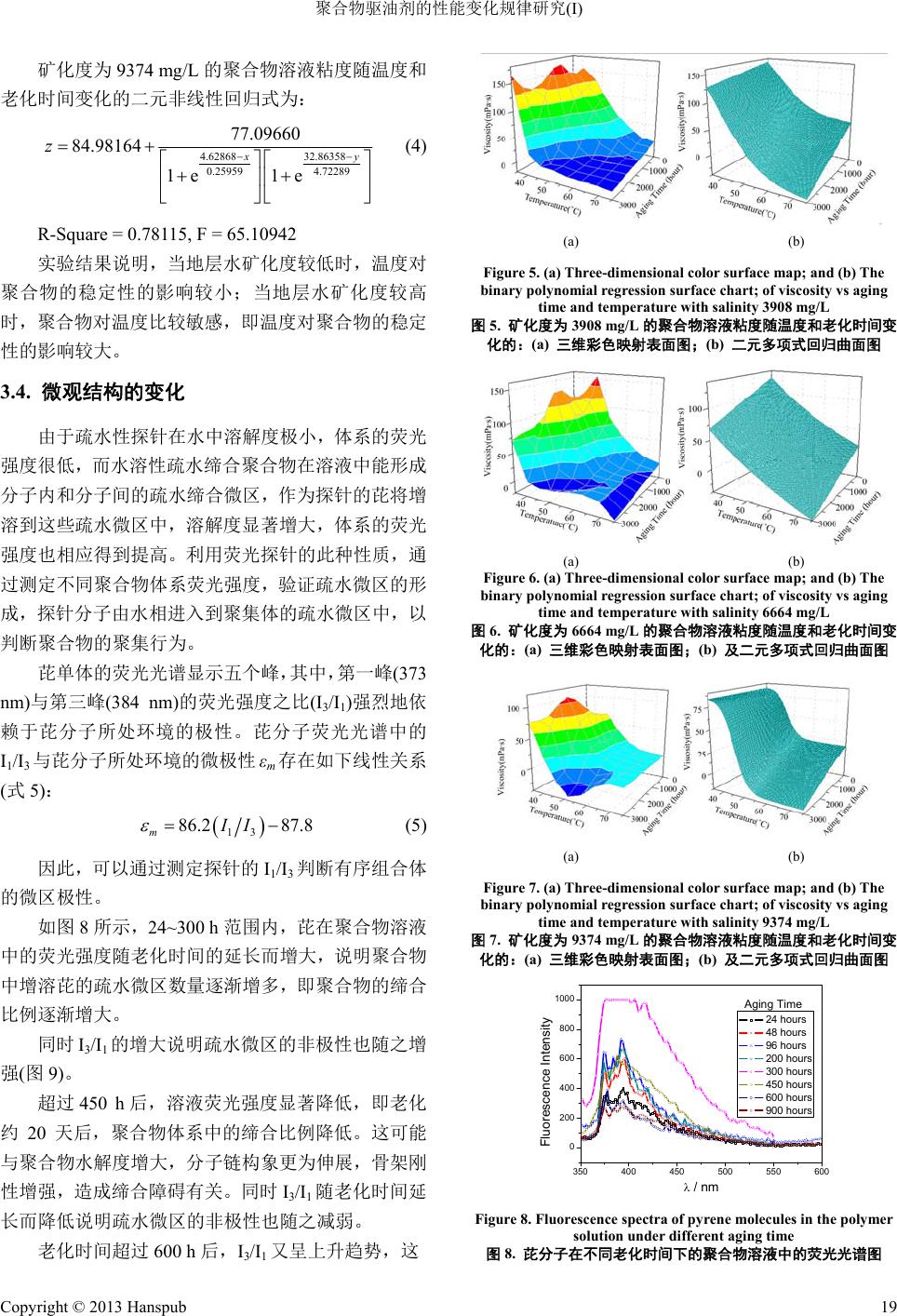 聚合物驱油剂的性能变化规律研究(I) 矿化度为9374 mg/L 的聚合物溶液粘度随温度和 老化时间变化的二元非线性回归式为: 4.62868 32.86358 0.259594.72289 77.09660 84.98164 1e 1e x y z (4) R-Square = 0.78115, F = 65.10942 低时,温度对 聚合 变化 溶解度极小,体系的荧光 强度 五个峰,其中,第一峰(373 nm)与 实验结果说明,当地层水矿化度较 物的稳定性的影响较小;当地层水矿化度较高 时,聚合物对温度比较敏感,即温度对聚合物的稳定 性的影响较大。 3.4. 微观结构的 由于疏水性探针在水中 很低,而水溶性疏水缔合聚合物在溶液中能形成 分子内和分子间的疏水缔合微区,作为探针的芘将增 溶到这些疏水微区中,溶解度显著增大,体系的荧光 强度也相应得到提高。利用荧光探针的此种性质,通 过测定不同聚合物体系荧光强度,验证疏水微区的形 成,探针分子由水相进入到聚集体的疏水微区中,以 判断聚合物的聚集行为。 芘单体的荧光光谱显示 第三峰(384 nm)的荧光强度之比(I3/I1)强烈地依 赖于芘分子所处环境的极性。芘分子荧光光谱中的 I1/I3与芘分子所处环境的微极性εm存在如下线性关系 (式5): 13 86.2 87.8 mII (5) 因此,可以通过测定探针的 I1/I3判 的微 ,24~300 h 范围内,芘在聚合物溶液 中的 大说明疏水微区的非极性也随之增 强(图 0 h后,溶液荧光强度显著降低,即老化 约2 老化时间超过600 h 后,I3/I 1又呈上升趋势,这 断有序组合体 区极性。 如图 8所示 荧光强度随老化时间的延长而增大,说明聚合物 中增溶芘的疏水微区数量逐渐增多,即聚合物的缔合 比例逐渐增大。 同时 I3/I1的增 9)。 超过 45 0天后,聚合物体系中的缔合比例降低。这可能 与聚合物水解度增大,分子链构象更为伸展,骨架刚 性增强,造成缔合障碍有关。同时I3/I1随老化时间延 长而降低说明疏水微区的非极性也随之减弱。 (a) (b) Figure 5. (a) Three-dimens i o n a l color surface map; and (b) The binary polynoity vs aging tim/L 图 mial regression surface chart; of viscos e and temperature with salinity 3908 mg 5. 矿化度为 3908 mg/L的聚合物溶液粘度随温度和老化时间变 化的:(a) 三维彩色映射表面图;(b) 二元多项式回归曲面图 (a) (b) Figure 6. (a) Three-dimens i o n a l color surface map; and (b) The binary polynomial regression surface chart; of viscosity vs agin tim/L 图 g e and temperature with salinity 6664 mg 6. 矿化度为 6664 mg/L的聚合物溶液粘度随温度和老化时间变 化的:(a) 三维彩色映射表面图;(b) 及二元多项式回归曲面图 (a) (b) Figure 7. (a) Three-dimens i o n a l color surface map; and (b) The binary polynity vs aging tim/L 图 omial regression surface chart; of viscos e and temperature with salinity 9374 mg 7. 矿化度为 9374 mg/L的聚合物溶液粘度随温度和老化时间变 化的:(a) 三维彩色映射表面图;(b) 及二元多项式回归曲面图 350 400 450 500 550 600 0 200 400 600 800 1000 Fluorescence Intensity / nm 24 hours Aging Time 48 hours 96 hours 200 hours 300 hours 450 hours 600 hours 900 hours Figure 8. Fluorescence spectra of pyrene m olecules in the polymer solution under d ifferent aging time 图8. 芘分子在不同老化时间下的聚合物溶液中的荧光光谱图 Copyright © 2013 Hanspub 19 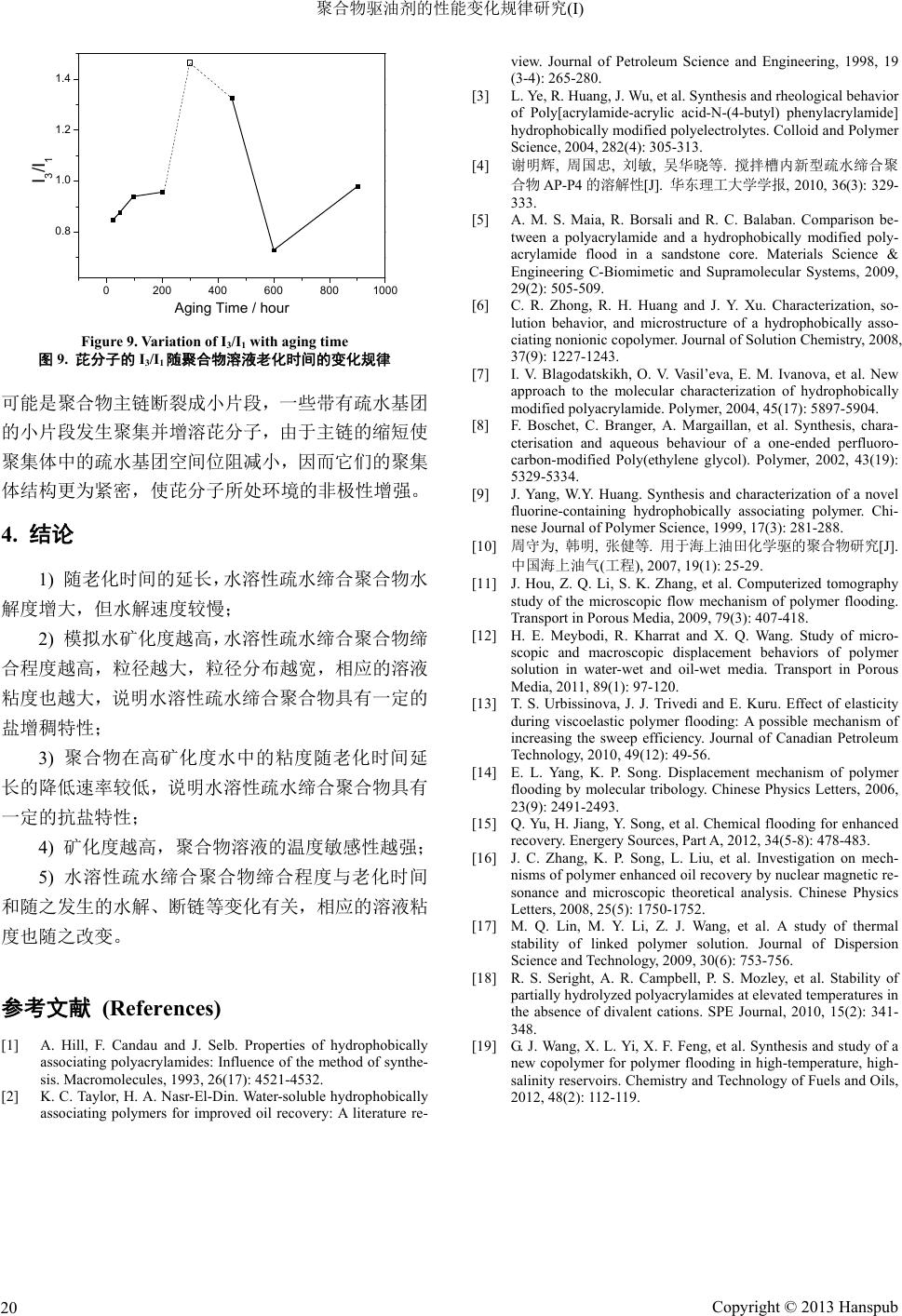 聚合物驱油剂的性能变化规律研究(I) Copyright © 2013 Hanspub 20 0200400 600 8001000 0.8 1.0 1.2 1.4 I3/I1 Aging Time / hour Figure 9. Variation of I3/I1 with aging time 图9. 芘分子的 I3/I1随聚合物溶液老化时间的变化规律 可能 小片段发生聚集并增溶芘分子,由于主链的缩短使 老化时间的延长,水溶性疏水缔合聚合物水 解度增大,但水解速度较慢; 布越宽,相应的溶 粘度 低,说明水溶性疏水缔合聚合物具有 一定 缔合聚合物缔合程度与老化时间 和随 度也 参考文献 (References) drophobically method of synthe- sis. Macr: 4521-4532. ide-acrylic acid-N-(4-butyl) phenylacrylamide] 工大学学报, 2010, 36(3): 329- polyacrylamide and a hydrophobically modified poly- nd microstructure of a hydrophobically asso- olecular characterization of hydrophobically o- aining hydrophobically associating polymer. Chi- er flooding. er looding: A possible mechanism of sics Letters, 2006, Sources, Part A, 2012, 34(5-8): 478-483. re- ution. Journal of Dispersion temperatures in opolymer for polymer flooding in high-temperature, high- view. Journal of Petroleum Science and Engineering, 1998, 19 (3-4): 265-280. [3] L. Ye, R. Huang, J. Wu, et al. Synthesis and rheological behavior of Poly[acrylam hydrophobically modified polyelectrolytes. Colloid and Polymer Science, 2004, 282(4): 305-313. [4] 谢明辉, 周国忠, 刘敏, 吴华晓等. 搅拌槽内新型疏水缔合聚 合物 AP-P4 的溶解性[J]. 华东理 333. [5] A. M. S. Maia, R. Borsali and R. C. Balaban. Comparison be- tween a acrylamide flood in a sandstone core. Materials Science & Engineering C-Biomimetic and Supramolecular Systems, 2009, 29(2): 505-509. [6] C. R. Zhong, R. H. Huang and J. Y. Xu. Characterization, so- lution behavior, a 是聚水基合物主链断裂成小片段,一些带有疏 团m ciating nonionic copolymer. Journal of Solution Chemistry, 2008, 37(9): 1227-1243. [7] I. V. Blagodatskikh, O. V. Vasil’eva, E. M. Ivanova, et al. New approach to the m odified polyacrylamide. Polymer, 2004, 45(17): 5897-5904. [8] F. Boschet, C. Branger, A. Margaillan, et al. Synthesis, chara- cterisation and aqueous behaviour of a one-ended perfluor 的 carbon-modified Poly(ethylene glycol). Polymer, 2002, 43(19): 5329-5334. [9] J. Yang, W.Y. Huang. Synthesis and characterization of a novel fluorine-cont 聚集体中的疏水基团空间位阻减小,因而它们的聚集 体结构更为紧密,使芘分子所处环境的非极性增强。 4. 结论 nese Journal of Polymer Science, 1999, 17(3): 281-288. [10] 周守为, 韩明, 张健等. 用于海上油田化学驱的聚合物研究[J]. 中国海上油气(工程), 2007, 19(1): 25-29. 1) 随[11] J. Hou, Z. Q. Li, S. K. Zhang, et al. Computerized tomography study of the microscopic flow mechanism of polym 2) 模拟水矿化度越高,水溶性疏水缔合聚合物缔 合程度越高,粒径越大,粒径分液 sol Transport in Porous Media, 2009, 79(3): 407-418. [12] H. E. Meybodi, R. Kharrat and X. Q. Wang. Study of micro- scopic and macroscopic displacement behaviors of polym ution in water-wet and oil-wet media. Transport in Porous Media, 2011, 89(1): 97-120. [13] T. S. Urbissinova, J. J. Trivedi and E. Kuru. Effect of elasticity during viscoelastic polymer f 也越大,说明水溶性疏水缔合聚合物具有一定的 盐增稠特性; 3) 聚合物在高矿化度水中的粘度随老化时间延 长的降低速率较 increasing the sweep efficiency. Journal of Canadian Petroleum Technology, 2010, 49(12): 49-56. [14] E. L. Yang, K. P. Song. Displacement mechanism of polymer flooding by molecular tribology. Chinese Phy 23(9): 2491-2493. [15] Q. Yu, H. Jiang, Y. Song, et al. Chemical flooding for enhanced recovery. Energery 的抗盐特性; 4) 矿化度越高,聚合物溶液的温度敏感性越强; 5) 水溶性疏水 [16] J. C. Zhang, K. P. Song, L. Liu, et al. Investigation on mech- nisms of polymer enhanced oil recovery by nuclear magnetic sonance and microscopic theoretical analysis. Chinese Physics Letters, 2008, 25(5): 1750-1752. [17] M. Q. Lin, M. Y. Li, Z. J. Wang, et al. A study of thermal stability of linked polymer sol 之发生的水解、断链等变化有关,相应的溶液粘 随之改变。 Science and Technology, 2009, 30(6): 753-756. [18] R. S. Seright, A. R. Campbell, P. S. Mozley, et al. Stability of partially hydrolyzed polyacrylamides at elevated the absence of divalent cations. SPE Journal, 2010, 15(2): 341- 348. [19] G. J. Wang, X. L. Yi, X. F. Feng, et al. Synthesis and study of a new c [1] A. Hill, F. Candau and J. Selb. Properties of hy associating polyacrylamides: Influence of the omolecules, 1993, 26(17)salinity reservoirs. Chemistry and Technology of Fuels and Oils, 2012, 48(2): 112-119. [2] K. C. Taylor, H. A. Nasr-El-Din. Water-soluble hydrophobically associating polymers for improved oil recovery: A literature re- |